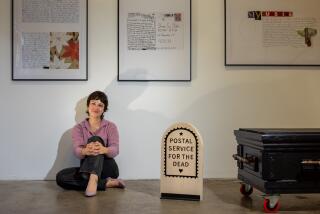Letters Reach Across Time to Show Pioneer Woman’s Courage
- Share via
BILLINGS, Mont. — On a lonely stretch of central Montana prairie, a young woman of Norwegian descent slaved to scratch out a living as a homesteader. It was 1911; Julia Erickson had come west with four other single female friends to make a new life.
The work was hard, town was miles away and accommodations were spartan. Yet Julia was full of dreams.
Now, through newly discovered letters she wrote to a long-dead South Dakota woman more than 80 years ago, she reaches through time to speak to her family.
Rene Graff of Aberdeen, S.D., served as intermediary--thanks to a construction project. She discovered old papers in her 19th century home and became immersed in frontier life through letters from four people she had never met. George, Melvina, Carl and Julia became “the dead friends” in her basement.
When she tracked down Julia’s son, Bill Stockton of Grass Range, Mont., she said: “You don’t know me. But I know Julia.”
*
I had an awful experience this morning behind my house. We have a little box dug down in the ground where we keep our butter and milk. Well, the board we have over the box is about 8 inches longer than the box.
Well, after I had taken the board off and put the milk in and was just trying to find a place for the butter, I saw one of the largest rattlesnakes I have ever seen coiled up right by the box. Last week I killed three but four is all we have seen since we came out and I have killed every one.--June 27, 1911
*
Stockton, 79, a retired sheep rancher, author, crusty social critic and artist, wasn’t as surprised as you might think by Graff’s call. “As soon as she mentioned Aberdeen, I knew what she was talking about,” he says. “Mother always talked about [Aberdeen].”
In 1911, at the age of 29, Julia Erickson set out from Minneapolis with four other single women to homestead near Winnett, on Montana’s eastern plains. Determined to prove up on her claim of prairie land, she had to live and work on it for five years. Then, under the Homestead Act, she could buy the parcel for a nominal fee.
To fill in the lonely times, Julia wrote to her childhood friend, Anna Kittleson, of Aberdeen. She described farming life and Montana’s beauty, told of useful gifts of water and drew a floor plan of her small prairie shack. Sometimes she wrote in Norwegian. She often signed off, “with oceans of love.”
“Julia was so cute,” Graff says. “Her letters were funny. She had a good sense of humor. It took a lot of guts for a single woman to do what she did.”
Two years after her arrival, Julia married William “Tex” Stockton, a civil engineer surveying the Chicago-Milwaukee line into nearby Grass Range. Two years after that, their first daughter, aptly named Patience, was born.
After toiling on the homestead, Julia knew all about patience.
*
Mrs. Beers [a neighbor] is one of the grandest women I have ever met. Good-hearted is no name for it. If she can’t give us anything else she will have us take some drinking water home so as not to have to make an extra trip down to the spring. I like Montana so well. Perhaps it’s because I have had such nice times and am feeling so much better.--Sept. 27, 1911
*
Julia’s daughter, Patience Hillius, is 85 now and lives in a retirement home in Hamilton, Mont. She got copies of the letters--some of them so fragile that Graff had to type them--and wished she had asked her mother more about homesteading life.
“I learned the answers to a number of questions I wished I had asked her,” Hillius says, “and [I] was surprised to learn of her enthusiastic love for Montana.”
The correspondence reminded Hillius and Stockton of stories their mother told them and provided some insight into a father they barely knew.
“In 1911, when my mother came from Minneapolis to take up a homestead in Montana, she had very little more than a woman’s courage and high hopes and dreams,” Hillius says.
Unfortunately, those hopeful days were dashed in 1920, when Tex Stockton died. Julia was left with four young children and a homestead to work. For three years the family struggled to stay afloat, but after the house burned down they moved into town. Julia worked odd jobs to support her family, and her homestead eventually reverted to the government.
“The hopes and dreams lasted only a few short years,” Hillius says. “But her courage lasted a lifetime.”
*
Dear Anna how I wish you were here this morning, everything looks just beautiful. Have been down in the garden, Bill, Mother and I. Have radishes and onions to eat and will have lettuce and spinach in a few days. I have 39 young chickens. Some are large enough to eat but neither of us has the heart to kill them. Oh this farm business is mighty interesting I tell you.--April 18, 1914
*
Graff’s “archeological dig” began when she and her husband wanted to insulate the attic. Part of their home was built in the 1890s. Its original owner was a traveling immigration agent who worked for the railroad. Anna, Julia’s friend, worked as his stenographer. Somehow, Anna’s personal letters got mixed in with the business correspondence, books and magazines--all of which ended up in the Graffs’ attic.
Rene Graff’s husband wanted to “burn the crap.” She disagreed. Instead, she filled sack after sack--a pickup-size load of old receipts for coal, the ice man and a surrey rental; National Geographic magazines from 1912, and old medicine books--and carried them to the basement. Someday, Graff promised herself, she would sort through the papers.
Twenty years later, she began.
What she found, as she meticulously culled the material, was a treasure trove of history. Most touching were the letters from George, Melvina, Carl and Julia, people she came to know and love.
“They’re like my family,” Graff says. “They’ve taught me different things. Melvina taught me poetry. Julia taught me guts.”
*
Thanks so much for the trouble you had in getting that crochet cotton. Have been having the worst time getting paper money or trying to. Will give it up as a bad job and send it in silver.--Dec. 3, 1914
*
The process of culling the old correspondence proved time-consuming. First, Graff had to decipher which letters belonged to which writer, trying to match handwriting. Then she had to try to organize them chronologically, since many had no dates. She had to type letters that were too fragile to handle repeatedly. Some of them were 10 pages and eloquently written.
“It was like a personal visit,” she says. “Now, with e-mail, we don’t even write in complete sentences.”
Graff found 40 missives from Julia to Anna, ending in 1917. But across the span of more than 80 years, Julia’s voice carries.
“As I reread the letters, those in her handwriting, I laughed with her during her happy homestead years and cried when I remembered the hard, difficult years that followed,” says her daughter, Hillius.
“The insistence my mother had to homestead was incredible,” Stockton says.
*
Got $58.90 clear after express was paid on the 24 turkeys we sent to Butte. Sold a gobbler the other day got $4.20.--March 24, 1916
*
On the Web: Tips on preserving old letters, photographs and newspaper clippings are available at: www.lib.cmich.edu/clarke/pres.htm
More to Read
Sign up for Essential California
The most important California stories and recommendations in your inbox every morning.
You may occasionally receive promotional content from the Los Angeles Times.













